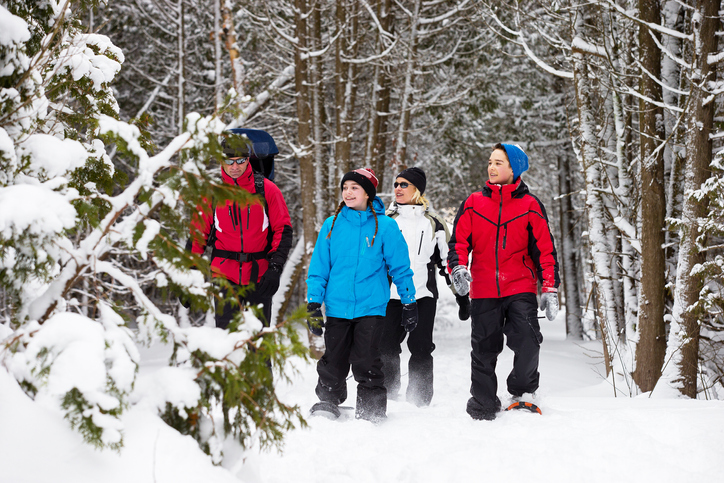By Samantha Breza
What supplies are needed on a snowshoeing trip depends on where the snowshoer is going and how long they’re going to be there. Snowshoers hiking on mountain trails during the winter need hydration systems, avalanche transceivers, signaling mirrors, and ice axes for avalanches. As it is Newaygo county doesn’t have mountains, so avalanches aren’t a major concern. Snowshoers that go off-trail on backcountry trips should have a map, compass, GPS, cell phone, and a snowshoeing companion in case of emergencies. For lengthy trips, snowshoers need a backpack with snacks and a thermos bottle of water or hot tea. Regardless of terrain or length of trip, snowshoers need winter clothes, waterproof boots and gaiters, snowshoe poles (if they’re new to snowshoeing), a thermos bottle, and snowshoes.

It’s important to stay warm and dry while using snowshoes to prevent hypothermia and frostbite. This means wearing long underwear, several layers of clothes made from wool or synthetic fibers like polyester, waterproof boots and gaiters, gloves, socks, scarves, and hats. Wear three layers; the first needs to be waterproof, the next layer to insulate, and a waterproof, windproof third layer. Do not wear cotton; cotton absorbs water and sweat only too well. Using cotton in the winter provides the wearer a cold, wet-and therefore heavier-layer of clothing until it can be removed, providing these garments don’t freeze first. All of this increases the likelihood of hypothermia and frostbite.
Hypothermia is when more heat from the body core is lost than what the circulatory symptom give. Hypothermia can be fatal and it doesn’t need to be freezing for hypothermia to happen. The best way to prevent hypothermia is to stay dry, physically active, and hydrated (hence the thermos bottle). People with hypothermia tend to stumble around and act disoriented. If you experience these symptoms or see someone with these symptoms, get to a warm building or car immediately and replace wet clothes with dry clothes.

Frostbite affects the skin’s surface and extremities and begins as “frost nip”. Frost nip is when your skin tingles; when it turns numb it has developed into frostbite, and when it loses sensation altogether it’s serious. If the skin is still soft the frostbite is mild, when it turns pale and hard it’s a medical emergency. The best defense against frostbite is prevention. It’s important to stay as warm and dry as possible. Wear warm clothing, but don’t make wear them too tightly since that will restrict body heat from getting around. If you or someone else develops frostbite, don’t run your skin because it could make it worse. Call 911; it only takes about five minutes to develop frostbite and it’s usually worse than what the affected person thinks it is. Get to a warm area and remove any wet clothes you might have on. Soak the frostbitten parts in warm water (104 F to 107 F) or use a warm washcloth on places that can’t be soaked (like your nose) for thirty minutes.
Bring sunglasses and sunscreen with you when you go out. Strange as it sounds, it’s possible to get sunburnt in winter. UV rays reflect off the snow and onto whatever skin isn’t bundled up. The sunglasses are for when this sunlight dazzles off the snow and temporarily blinds anyone who happens to be walking by.
Gaiters are cloth-like tubes that go over boot tops and have instep straps attached to them to put around the bottom of the boots. They keep snow, slush, and ice out by covering up the space between the user’s boots and trousers. Gaiters come in different sizes. The deeper the snow, the longer the gaiter needs to be. It’s generally better to err on the side of caution and wear long gaiters off-trail where snow depth can be unpredictable.
Snowshoe poles are similar to canes except the have adjustable lengths and spikes on the bottom for traction. It takes a while to get use to walking in snowshoes and having a pair of poles improves balance and can be used to regain balance after falling over, walking up or down hills, or on slippery terrain. Snowshoe poles are a greater ascent for beginners than experienced snowshoers.
These supplies can be located at Dunhams Sports on Fremont’s Main Street or at Hesperia’s Sports Shop on Alpha Street in Hesperia.
Sources:
https://www.rei.com/learn/expert-advice/gaiters.html
https://www.rei.com/learn/expert-advice/snowshoeing-first-steps.html
https://www.rei.com/learn/expert-advice/snowshoe-checklist.html
The Snowshoes Experience by Claire Walter
https://www.webmd.com/skin-problems-and-treatments/frostbite-how-spot-treat-prevent#1
https://www.webmd.com/skin-problems-and-treatments/frostbite-how-spot-treat-prevent#2





